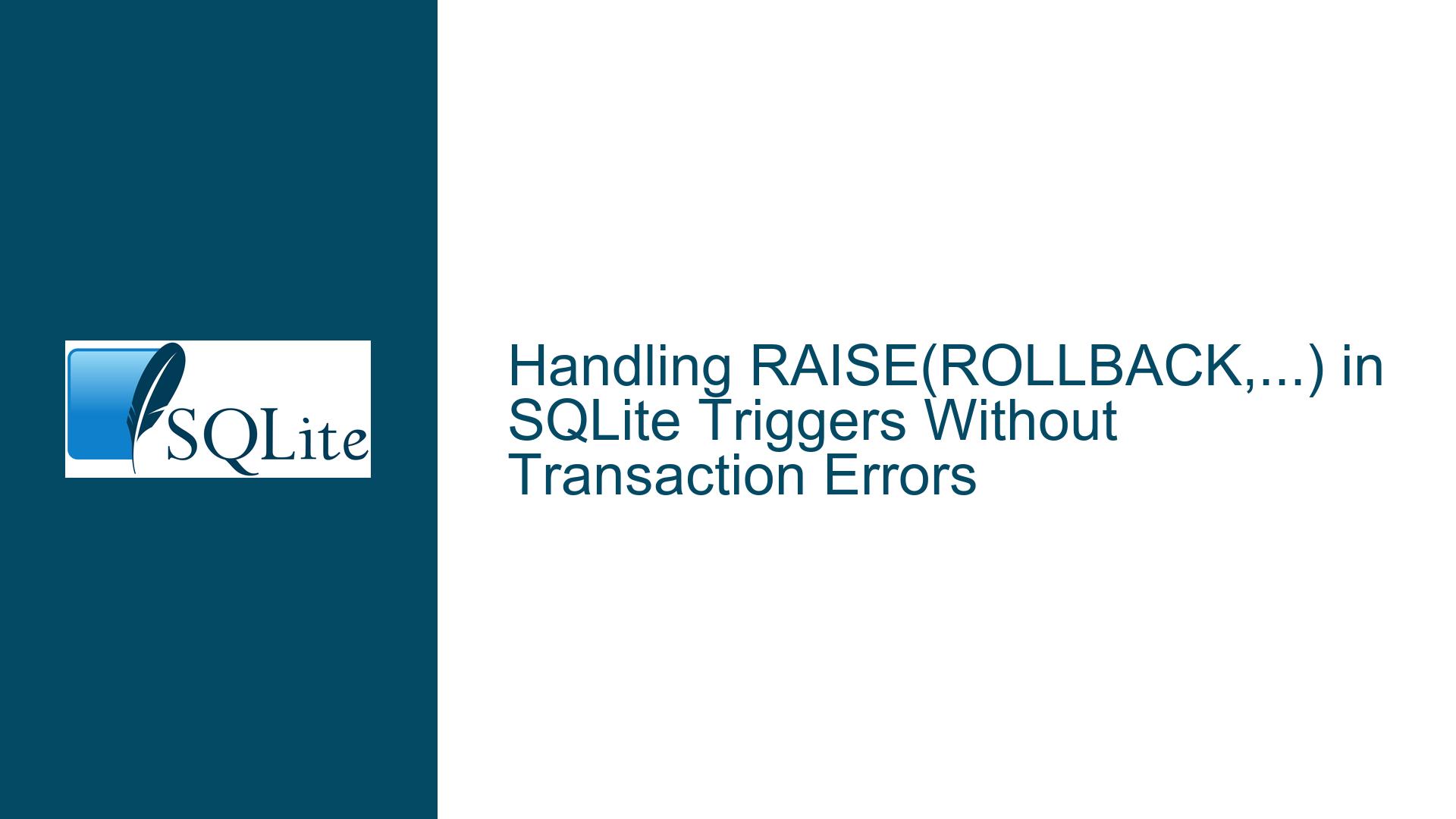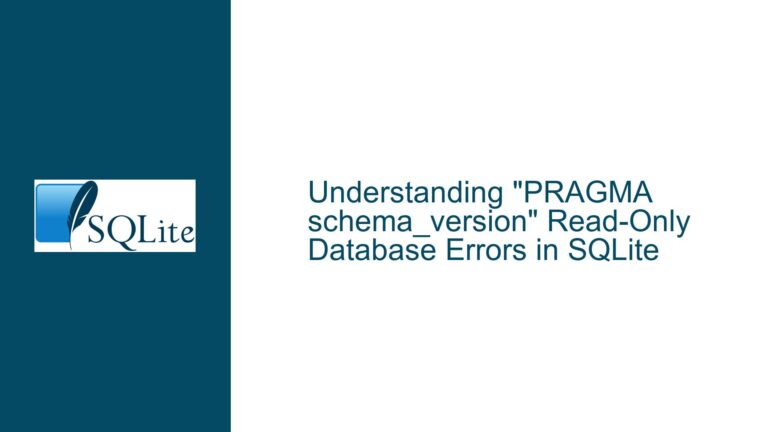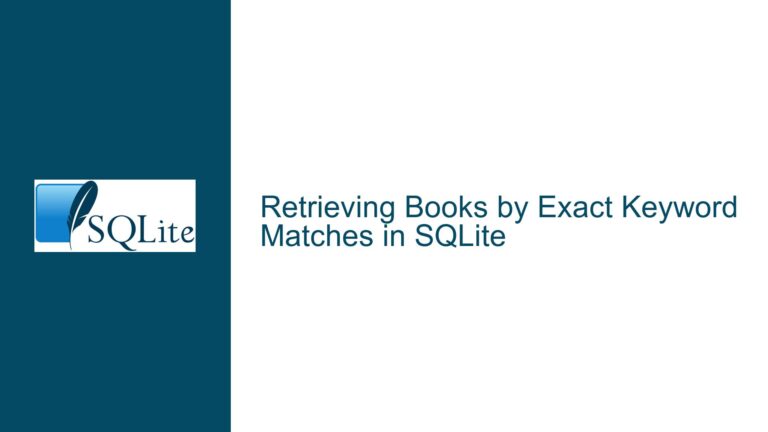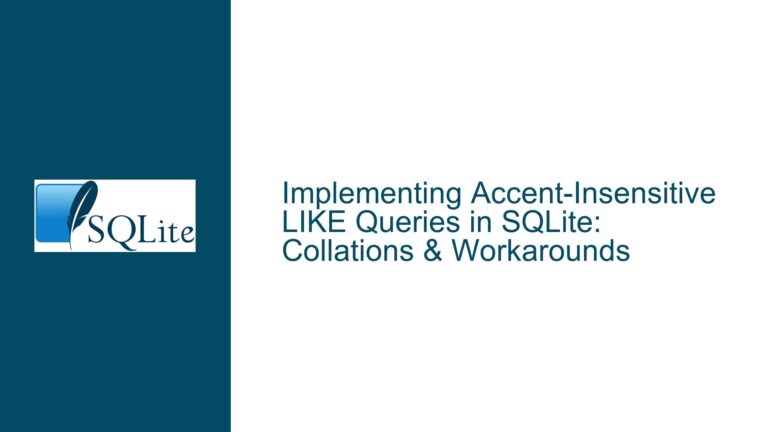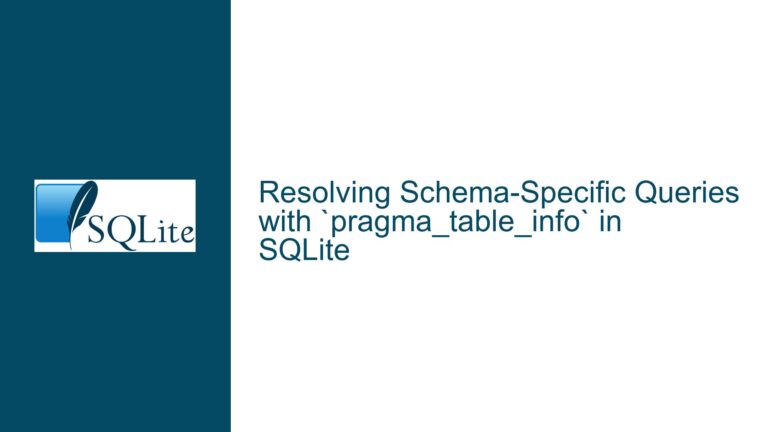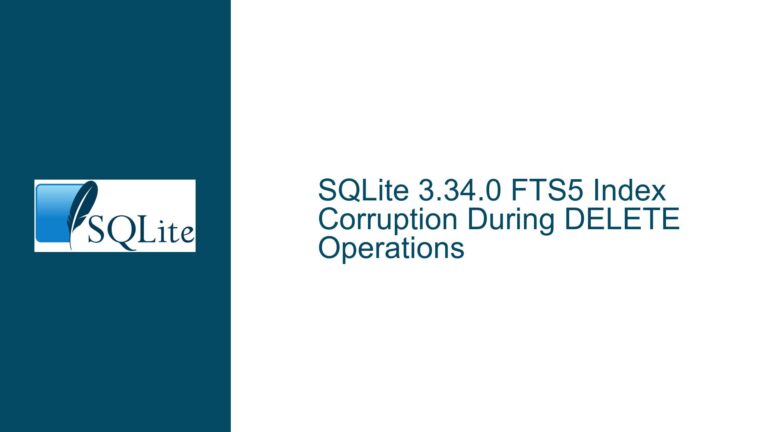Handling RAISE(ROLLBACK,…) in SQLite Triggers Without Transaction Errors
RAISE(ROLLBACK,…) Trigger Behavior in SQLite
When working with SQLite triggers, the use of RAISE(ROLLBACK,...) can lead to unexpected behavior, particularly when the trigger is executed outside of an explicit transaction. The core issue arises from the fact that RAISE(ROLLBACK,...) attempts to roll back the entire transaction, but if no transaction is active, SQLite throws a "no transaction" error. This behavior can be problematic in scenarios where the same trigger needs to function both within and outside of an explicit transaction.
The RAISE(ROLLBACK,...) command is designed to abort the current transaction and revert any changes made within that transaction. However, if no transaction is active, SQLite has no transaction to roll back, leading to the error. On the other hand, using RAISE(ABORT,...) only aborts the current statement, not the entire transaction. This distinction is crucial when designing triggers that need to handle both implicit and explicit transactions gracefully.
The challenge is to create a trigger that can roll back the entire transaction when executed within an explicit transaction but only abort the current statement when executed outside of a transaction. This requires a mechanism to detect whether the trigger is running within an explicit transaction or not. Unfortunately, SQLite does not provide a built-in function to determine the current transaction state directly within SQL. This limitation necessitates alternative approaches to achieve the desired behavior.
Interrupted Write Operations Leading to Index Corruption
One of the primary reasons for the confusion around RAISE(ROLLBACK,...) in triggers is the assumption that all database operations occur within a transaction context. In SQLite, every write operation (INSERT, UPDATE, DELETE) is implicitly wrapped in a transaction if no explicit transaction is active. This means that even if a user does not explicitly start a transaction, SQLite will automatically create an implicit transaction for the duration of the write operation. However, this implicit transaction is different from an explicit transaction started with the BEGIN command.
When a trigger is fired, it operates within the context of the transaction that initiated the trigger. If the trigger attempts to execute RAISE(ROLLBACK,...) and no explicit transaction is active, SQLite will throw a "no transaction" error because it cannot roll back an implicit transaction. This behavior is consistent with SQLite’s design, where implicit transactions are automatically committed or rolled back at the end of the statement, and there is no way to manually control them.
The issue is further complicated by the fact that SQLite’s transaction handling can vary depending on the version of SQLite being used. For example, in some versions of SQLite, RAISE(ROLLBACK,...) might behave differently when executed within a trigger compared to other versions. This inconsistency can lead to confusion and unexpected behavior, especially when migrating databases between different versions of SQLite.
Another factor contributing to the issue is the potential for interrupted write operations. If a write operation is interrupted (e.g., due to a power failure or system crash), the database might be left in an inconsistent state. In such cases, the use of RAISE(ROLLBACK,...) within a trigger could exacerbate the problem by attempting to roll back a transaction that was already interrupted. This could lead to index corruption or other database integrity issues.
Implementing PRAGMA journal_mode and Database Backup
To address the issue of RAISE(ROLLBACK,...) in triggers, several strategies can be employed. One approach is to use the PRAGMA journal_mode setting to control how SQLite handles transactions and ensures data integrity. The journal_mode pragma determines how SQLite logs changes to the database, which can affect how transactions are rolled back in the event of an error.
For example, setting PRAGMA journal_mode=WAL (Write-Ahead Logging) can improve concurrency and provide better control over transaction rollbacks. In WAL mode, SQLite writes changes to a separate log file before applying them to the main database file. This allows for more efficient rollbacks and reduces the risk of database corruption in the event of an interrupted write operation.
Another strategy is to implement a database backup mechanism that can be used to restore the database to a consistent state in the event of an error. This can be done using SQLite’s built-in backup API, which allows for the creation of a backup copy of the database while it is still in use. By regularly backing up the database, you can ensure that you have a consistent state to fall back on if a transaction rollback fails or leads to database corruption.
In addition to these strategies, it is important to carefully design triggers to handle both implicit and explicit transactions. One way to achieve this is by using a combination of RAISE(ABORT,...) and RAISE(ROLLBACK,...) within the trigger, depending on the context in which the trigger is executed. For example, you could use a user-defined function (UDF) to check whether an explicit transaction is active and then conditionally execute RAISE(ROLLBACK,...) or RAISE(ABORT,...) based on the result.
Here is an example of how this might be implemented:
-- Create a table and a trigger that uses a UDF to check for an explicit transaction
CREATE TABLE example_table (id INTEGER PRIMARY KEY, value TEXT);
-- Define a UDF to check for an explicit transaction
SELECT sqlite3_create_function(db, 'is_explicit_transaction', 0, SQLITE_UTF8, NULL, is_explicit_transaction_impl, NULL, NULL);
-- Create a trigger that conditionally raises ROLLBACK or ABORT
CREATE TRIGGER example_trigger BEFORE INSERT ON example_table
FOR EACH ROW
BEGIN
SELECT CASE
WHEN is_explicit_transaction() THEN RAISE(ROLLBACK, 'Explicit transaction rolled back')
ELSE RAISE(ABORT, 'Statement aborted')
END;
END;
In this example, the is_explicit_transaction UDF is used to determine whether an explicit transaction is active. If an explicit transaction is active, the trigger raises a ROLLBACK error, which rolls back the entire transaction. If no explicit transaction is active, the trigger raises an ABORT error, which only aborts the current statement.
By using these strategies, you can create triggers that handle both implicit and explicit transactions gracefully, without causing errors or database corruption. It is also important to test your triggers thoroughly in different scenarios to ensure that they behave as expected and do not introduce new issues.
In conclusion, the issue of RAISE(ROLLBACK,...) in SQLite triggers can be addressed by carefully designing triggers to handle both implicit and explicit transactions, using the PRAGMA journal_mode setting to control transaction handling, and implementing a database backup mechanism to ensure data integrity. By following these best practices, you can avoid the pitfalls associated with transaction rollbacks in triggers and ensure that your database remains consistent and reliable.
